The sequence

The Correct Answer and Explanation is:
The correct answer is: e. neither increasing nor decreasing
To understand why, we examine the behavior of the sequence defined by
{1n−(−1)n}n=0∞\left\{ \frac{1}{n – (-1)^n} \right\}_{n=0}^{\infty}
This sequence depends on the parity of nn, because (−1)n(-1)^n alternates between 1 and -1 depending on whether nn is even or odd.
- For even nn, (−1)n=1(-1)^n = 1, so the general term becomes 1n−1\frac{1}{n – 1}
- For odd nn, (−1)n=−1(-1)^n = -1, making the term 1n+1\frac{1}{n + 1}
This split means the sequence alternates between two sub-sequences: one involving 1n−1\frac{1}{n – 1} and the other involving 1n+1\frac{1}{n + 1}. Let’s compute the first several terms:
- n=0n = 0: 10−1=−1\frac{1}{0 – 1} = -1
- n=1n = 1: 11+1=12\frac{1}{1 + 1} = \frac{1}{2}
- n=2n = 2: 12−1=1\frac{1}{2 – 1} = 1
- n=3n = 3: 13+1=14\frac{1}{3 + 1} = \frac{1}{4}
- n=4n = 4: 14−1=13\frac{1}{4 – 1} = \frac{1}{3}
- n=5n = 5: 15+1=16\frac{1}{5 + 1} = \frac{1}{6}
Now notice how the values rise and fall inconsistently. From n=0n = 0 to n=1n = 1, the value jumps from -1 to 0.5. Then it goes to 1, back to 0.25, up to 0.333, and down to 0.167. These fluctuations show neither a strictly increasing nor decreasing pattern. Furthermore, even considering magnitude, the values do not follow a consistent trend in any direction.
Therefore, the sequence fails all definitions for monotonic behavior, making option e the only valid choice.
